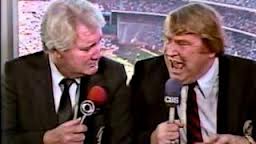1. From the performance itself (a self-evaluation)
2. Crowd reaction may play a role at this point
3. From their coach or coaches
4. From their teammates
5. From the immediate environment (other coaches or gymnasts in the area)
6. From the judge (a score)
(In a women’s meet they will repeat this process 4 times, once for each event).
7. From the awards ceremony (where did they place on each event)
8. From parents, family and friends who were in attendance
Every sport has its own chronology of feedback. In some sports feedback from an official is nearly immediate, “Strike three, you’re out!” putting it in front of information from a coach or teammate. In other sports, such as gymnastics, it’s delayed. We teach our gymnasts to set their goals based on performance standards, not scores. While judges are calculating scores we have an opportunity to give feedback based on performance and goals. This puts coach feedback in the line up before judge feedback, which works great for us.
For best results, all adults involved need to understand the typical order of feedback in their child’s sport and how it affects their role in the situation. A coach or parents place in the line up will have an affect on what type of feedback they should provide. A parent shouldn’t run to the dugout to tell their child to “watch the ball ‘til it hits the bat”, and a coach shouldn’t go home for dinner with the family just to say how much he liked Johnny’s diving catch in the second inning. A tuned in coaching staff can manipulate the order to a certain degree. And they should if that’s what’s best for the athlete.
After a game, Johnny has heard from his coaches, teammates, the umpires and himself concerning his performance. He doesn’t need technical information from his parents at that moment. What he’d probably enjoy is hearing what they liked best about the game. “Nice diving catch in the second.” Not technical information, just what made his parent’s happy. It would be good for him to hear what his parents enjoyed about how others played as well, as long as it’s not a comparison to his performance.
Not only should the adults involved be aware of the order of feedback given, but they should also consider the importance the athlete gives to each piece of feedback and should have a clear understanding of their role as a feedbacker (I think I made that word up, but it seems to fit, so I’ll run with it).
Pat Summerall: “John, this team has quite a feedbacker crew.”
John Madden: “I’ll say, have you been watching that middle feedbacker. He’s over here, then he’s over there, then he’s back down here. He seems to be everywhere. That young athlete’s lucky to have someone he can trust on his side. It’s seems like the feedbacker can read his mind and knows just what to say.”
John; “He’s always first on the scene, throwing encouragement everywhere, there’s still some lying on the field, see it over there. He mixes in a little technical or tactical information, followed by some more positive comments, and WAM, you’ve got a feedback sandwich. Makes me hungry, anyone seen my turkey?”
John: “oh, oh yeah. And, those outside feedbackers, they cover their territory, analyze the situation and never leave their posts unless needed.
Pat: “Don’t forget those drop-back feedbackers.”
John: “Oh, of course not. Every kid needs his drop-back feedbackers. Those who drop-back, watch the whole scene and provide unconditional, positive support. This kid’s parents are great at that.”
Everyone plays a role in the process. Coaches and parents in particular, but also officials, teammates, parents of teammates, etc. need to consider:
- Where you are in the feedback line-up.
- What are the needs of the child athlete when they reach your spot in the line-up.
- Are you the right person to fill those needs or should another “feedbacker” take that role?
With a little practice you will get very good at this quick analysis and you’ll find that you are there when you need to be, not there when you shouldn’t be and comfortable knowing your child is getting the best feedback available.




No comments:
Post a Comment